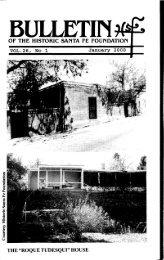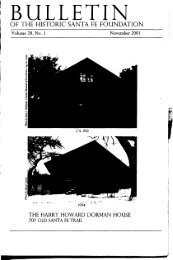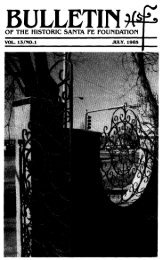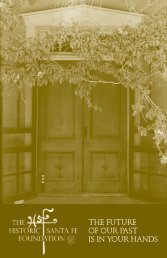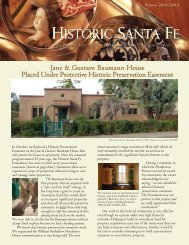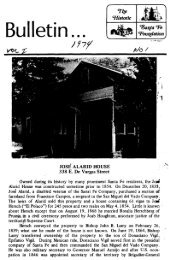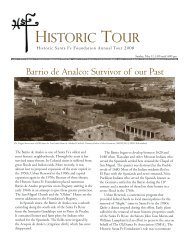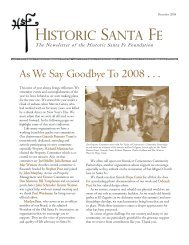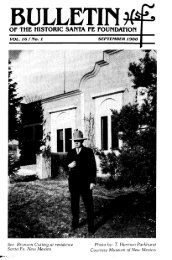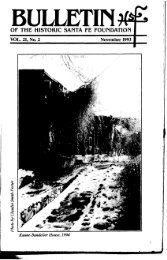Witter Bynner House - Historic Santa Fe Foundation
Witter Bynner House - Historic Santa Fe Foundation
Witter Bynner House - Historic Santa Fe Foundation
You also want an ePaper? Increase the reach of your titles
YUMPU automatically turns print PDFs into web optimized ePapers that Google loves.
SETON VILlAGE-lANDMARK<br />
AT RISK<br />
Mary Ann Anders<br />
Ernest<br />
artist, Thompson author, scientist, Seton,<br />
and naturalist of world renown,<br />
settled at the age of 70 about six<br />
miles southeast of <strong>Santa</strong> <strong>Fe</strong>.<br />
There, on a 2,500-acre tract of<br />
land Seton established his summer<br />
center for the American<br />
Woodcraft League and constructed<br />
three houses. The last,<br />
called the "Castle," was the<br />
most ambitious, becoming<br />
home, museum library, art<br />
gallery and institute for creative<br />
people in every discipline. The<br />
community, known as Seton<br />
Village, that grew up around<br />
the Castle was composed of<br />
like-minded individuals. Here,<br />
in this creative environment,<br />
Seton lived, created and taught<br />
until his death in 1946.<br />
The National Park Service<br />
designated Seton Castle and<br />
portions of Seton Village a<br />
National <strong>Historic</strong> Landmark in<br />
1965 for its association with<br />
Ernest Seton, "... a conservationist<br />
active in the Boy Scout<br />
movement. "1 After the passage<br />
of the National <strong>Historic</strong><br />
Preservation Act of 1966, as<br />
amended, the property was listed<br />
in the National Register of<br />
<strong>Historic</strong> Places on October 15,<br />
1966.<br />
Buildings identified on the<br />
nomination for the National<br />
Register as part of the<br />
Landmark are Lagunita, Seton's<br />
19<br />
second house, the Pullman Car<br />
house, the adobe house, the red<br />
barn, the print shop, the craft<br />
shop, the submarine, Zoo<br />
Lodge, Foothill Lodge, and an<br />
assortment of other small houses<br />
constructed either of adobe<br />
or built around other structures<br />
such as a trailer, the Castle or<br />
two structures that represent a<br />
Pueblo kiva and a Navajo<br />
hogan.2<br />
U.S. Department of Interior<br />
staff inspected the buildings<br />
within the boundaries of the<br />
landmark in 1981 and reported<br />
that "All of the features<br />
described in the original nomination<br />
are still standing and are<br />
in relatively good condition.<br />
The hogan and kiva are correct<br />
in dimension and configuration,<br />
and they include outstanding<br />
murals painted by a Kiowa<br />
artist. Both of these structures<br />
are in need of rehabilitation<br />
work on the roofs and some stabilization<br />
around the foundations."3<br />
In 1985-86the National Park<br />
Service prepared a. condition<br />
assessment report for the<br />
Castle, kiva and hogan. All<br />
three structures were given the<br />
Park Service Priority 1<br />
Endangered status because all<br />
three structures have suffered<br />
loss of architectural and artistic<br />
features and historic materials<br />
from lack of maintenance or<br />
repair and from vandalism.<br />
J



